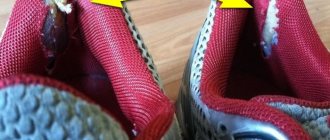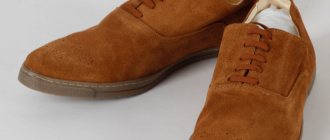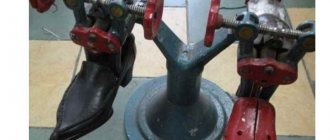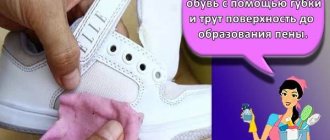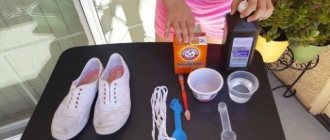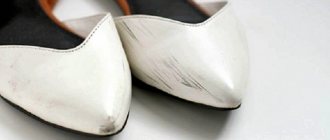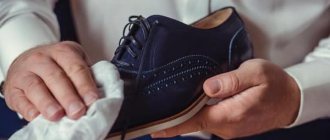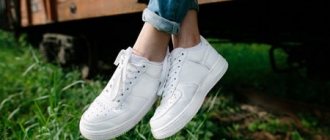10 August 2020
Sneaker care
Sneakers are the most popular footwear today, providing comfort and a stylish appearance. But no matter how high-quality they are, sooner or later everyone “gets sick” and requires “treatment.” Defects can occur externally or internally. If the damage is not too serious, it will be much cheaper to repair it yourself than to buy a new pair.
If you rub your heel in sneakers
Chafing heels are a fairly common symptom of recently purchased shoes. In order not to carry around a pack of adhesive plasters to cover abrasions, you need to solve the problem as soon as the problem arises. To do this, you can use the following tips:
- Special silicone stickers on the heels of shoes prevent the appearance of calluses;
- To soften hard heels, use a hammer to lightly tap the back of leather shoes from the inside;
- Place a towel soaked in warm water in the shoes and leave for 20-30 minutes. After this, apply pharmaceutical glycerin to the water-softened backdrops and leave until the morning. If this procedure does not help the first time, it is recommended to repeat it;
- If shoes have been left for a long time without proper care, the leather can dry out and rub the heels. To cope with this problem, you need to lubricate the back with baby cream, fat or soap and leave it overnight;
- If your sneakers are rubbing at the back due to the seam running along the heel, you should contact a shoe repair shop. The master will install a patch made of soft material in this place. In addition, the workshop offers a service for stretching shoes to length, which will also help achieve wearing comfort.
Other types of glue:
- An excellent adhesive option is American Seamgrip glue. It is used to seal rubber boats. If you manage to purchase it, you won’t have to part with your favorite pair of sneakers. This is the only type of glue that can completely solve the problem of holes in a polyurethane or rubber sole.
- Imported epoxy adhesives like Done Deal are much better than domestic adhesives, but you can’t promise durability for sneakers when using it.
How to repair sneakers: restoration of the heel
Over time, the following changes occur with the backdrop: the material tears, the inner lining comes out, and discomfort occurs due to deformations. To repair a torn backdrop, you must first cut off the frayed edges at the lining. Then a piece of thin soft leather is selected. A blank shaped like a small horseshoe is cut out of it. This part is treated with shoe glue (the edges are coated especially carefully).
The most important stage of the work is to carefully cover the “wounded” area of the back with a patch, and then straighten it with your fingers so that there are no wrinkles. Then place an object of suitable size inside to press the material tightly for several hours to securely fix the patch.
Take off and put on sneakers only unlaced
Because of the rush, we don't untie our sneakers. At such moments, we overcome the resistance of the backdrop to take off our shoes. Think about it: the heel, which is designed to support our foot, resists our pressure every time. We win, but the heel of the sneaker loses and wears out faster.
On many sneakers, the lacing even goes along the instep of the foot. This helps avoid ankle injuries. In such cases, it is necessary not only to untie the laces, but also to loosen the lacing.
Moleskin
You can take the additional steps above by using a self-adhesive material called Moleskin. It's designed to put you on your feet, but you can instead adjust it to your shoes for a more secure fit.
You may have to replace it from time to time, but it's inexpensive and has the added bonus of adding enough padding to make them more comfortable.
Tread rehabilitation
The vulnerable part is the protectors, especially their heel part. For example, due to active use they may burst. If you need to repair these elements, you will need a piece of hard rubber (the sole of some unnecessary shoes may come in handy). You will also need coarse sandpaper, a sharp knife, and shoe glue. The algorithm of actions will be as follows:
- A rubber patch is cut out to match the shape of the old tread.
- The patch is given a wedge-shaped shape using a knife and sandpaper.
- To make the surfaces to be glued rough, they are treated with sandpaper. Then they are wiped with solvent and left to dry.
- The patch is covered with two layers of glue. The area where the new protector will be placed is processed in the same way. The first layer dries in 20 minutes, and the second in about 5 hours.
- After the adhesive composition has dried, the surfaces are heated over the stove until a characteristic odor appears. Then they are pressed tightly against each other and held until they cool down and are firmly fixed.
Can I wear sneakers with repaired treads right away? If there is an urgent need, then this is permitted. However, it is better to wait a day before using it - this will make the design as reliable as possible.
Read also: How to cancel uploading to Google Drive?
How to repair a heel
To repair heels on sneakers, you need to get rid of the old tread, tearing it off the sole, cutting it in places where it is impossible to separate the element manually. To simplify the task, you can treat problem areas with a solvent.
After removing the tread, the contour of the sole is transferred to thick paper or cardboard and the erased edges are completed. Having drawn the outline, the pattern is cut out of paper and used to create a new blank. You can make the sole from a rubber mat, which is sold in hardware stores. It is impractical to partially restore the sole, so if the heel of the sneakers is damaged, the base is completely changed.
When gluing the sole to the main part of a sports shoe, you need to thoroughly clean the surface. Otherwise, the gluing procedure does not differ from the standard one.
How to repair the heel of a sneaker
Damage to the back of sneakers manifests itself in different ways: the fabric tears, the inner lining comes out, and discomfort appears in the heel.
When repairing shoes at home, you can take the following steps:
Important nuances
When planning repairs, you should take into account that different sports models differ in their materials. Further actions will largely depend on this.
In general, the following areas are susceptible to damage:
- sock;
- backdrop;
- heel;
- tread;
- sole.
! A pressing problem is cracks in the folds (most often leather shoes suffer).
Why does this happen?
- The most common option is poor quality shoes. If the materials from which the shoes were made are of very low quality, then the shoes will quickly wear out at all places where they are folded.
- Health. About 80% of the population have various types of foot deformities to one degree or another. In accordance with the characteristics of gait, overload zones appear in the areas of “shifts” of the pressure curve, and at a certain age, corns form. The skin of the outer edge of the heel, the forefoot, and the inner edge of the big toe are especially affected. This is where excessive shoe wear occurs. Most often, excessive shoe wear causes flat feet. With this disease, a person simply cannot place his foot correctly and evenly, as a result of which the shoes quickly lose their shape and wear out. The same goes for the heel. If the shoe itself is severely deformed, then the heel begins to wear out.
- Influence of type of activity. Many dancers who wear professional dance shoes complain that even expensive ballet shoes wear out quickly. The reason here is that dancers have too much mobility in their feet. Even when walking normally, they arch their foot, causing the heel to rub. But most often car drivers face this problem. When you constantly press the gas brake pedal, the heel rubs against the plastic. To avoid this, you just need to drive the car more carefully and watch where your foot is positioned on the pedals. If you can’t do this, then special “overlays” for shoes are sold for such cases. They are easy to put on any shoe. Made from a variety of materials and colors, this type of “shoe” for your shoes will protect them and extend their lifespan.
THEY WERE CHANGED WITH SOLES OR WHAT ARE NIKES AFRAID OF?
How to properly care for sneakers, why paint the soles, and why winter is terrible for Nikes,” said Vladimir Pavlovsky, owner of the SNEAKERHEAL sneaker repair shop.
Vladimir, why sneakers?
I am a shoe production technologist by profession and graduated from the Moscow University of Design and Technology. While I was studying, I became interested in restoration and participated in the GutFab project - cleaning shoes in a chair. Our points were in Moscow, Voronezh, Samara, St. Petersburg. When I graduated, I went to work at the BARKER shoe repair shop. Then the culture of sneakers began to “make its way” to Russia and the classics began to fade into the background for me. I chose sneakers because they have an interesting design, variety of materials and technologies. We can say that the niche has not been occupied until now. Many people didn’t understand why I was doing this, because sneakers are cheaper than classics and usually no one repairs them. They wear out faster and are easier to buy new ones.
Yes, repairs are generally not cheap. If sports shoes are being repaired specifically in order to continue playing sports, it makes sense to hem them or glue them with something. But the main focus of the workshop is the aesthetic restoration of sneakers. Repair should not only eliminate the problem of shoe wear. It should not violate the design, or even complement the appearance of the sneaker. We try to follow this motto!
What brands are most often brought?
The most popular are New Balance, adidas, Nike, Reebok, Saucony. I don’t remember that they brought Demix: their repair is unprofitable due to the low price of the sneakers. The average cost for painting or dry cleaning is 2,000 rubles. If sneakers cost five thousand rubles, then you shouldn’t repair them. If the cost of repair is no more than a third of the cost of the shoe, then it makes sense. They often bring New Balance and other sneakers, the price tag of which starts from 10 thousand. It would be a shame to throw away these sneakers.
Name the most reliable models.
It's difficult to talk about any specific brand. I would classify by the materials that are used. The most durable sneakers are made from leather and suede. Winter models are stronger because... the package of materials is calculated for an aggressive environment: low temperatures, high humidity, poor adhesion.
As for soles, their properties also depend on the source material.
Polyurethane soles are good to wear - it weighs little, as it has a porous structure, resists abrasion well, is flexible, has excellent shock absorption and good thermal insulation. They also use thermopolyurethane, whose high density is also its disadvantage, because because of this the weight of the sole is quite large, and the elasticity and thermal insulation leave much to be desired. To improve these characteristics, TPU is often combined with polyurethane, thereby reducing the weight of the sole, increasing its thermal insulation and elasticity
Thermoplastic elastomer soles. This material can be considered all-season. It is durable, elastic, resistant to frost and wear.
Polyvinyl chloride soles resist abrasion well, are resistant to aggressive environments and are easy to manufacture. But they don't hold the temperature well.
Soles made of ethylene vinyl acetate (EVA), a very light material with good shock-absorbing properties. Most often, summer and beach shoes are made from it, and in sports shoes it is used in the form of inserts, because it is able to absorb and distribute shock loads. EVA soles lose their shock-absorbing properties over time. This occurs because the pore walls break down and the entire mass of EVA becomes flatter and less elastic.
DRC rubber compound. Pure rubber mixed with additives is the most reliable type of rubber, which is not afraid of almost anything. This mixture is used in walking or tennis shoes.
Duralon. Another mixture of artificially created rubber, obtained by blowing. It wears out quickly, but it contains air pores that provide excellent shock absorption. This material is often used in the toe part of running shoes.
And the most unreliable ones?
Fabric materials. They wear out quickly, do not regain their shape, and do not stretch.
How long can sneakers last, if you ignore the marketing horror stories about the resource?
Sneakers can last a couple of seasons. I can’t say in terms of mileage... The more dynamic and active the sport, the more wear and tear. If you take running, during training the bundle part is subject to wear, that is, the bending point. For a heavier runner, the EVA sole will deteriorate faster and become flat. Technologies make it possible to correctly use materials and make highly specialized shoes, which, fulfilling their purpose, die over time, but this does not mean poor quality, it indicates improper use. We don't eat soup with a fork. Likewise, sports shoes should not be perceived as casual, and summer shoes as winter ones. If the shoes are intended for running, they should be airy, elastic, and well ventilated. Materials that meet these qualities cannot always be both strong and durable. But this is not a priority.
Can we talk about some proprietary problems that are specific to the sneakers of a particular company?
Nike's trademark problem is Air technology. Recently, cylinders have begun to be made thinner, reducing weight and reducing service life. As a result, they began to burst more often. In sneakers of the 90s, the rubber cushion was 2 millimeters thick, but now it is getting smaller. Look, here's Nike from 1990 - the cylinders are still intact and the sole is just starting to crumble. Air technology is not used in Russia due to the fact that shoes are worn in winter. Rubber hardens at low temperatures and continues to perform its function of cushioning sneakers, but due to the low temperature the rubber bursts and cracks. And the balloon comes to an end.
The further the improvement of sneakers goes, the larger the cylinders. If it bursts, then you won't be much different. Now in the workshop we are working on choosing a material to fill the pillows so that it does not add much weight and remains elastic. We try different materials.
You know, “trademark sores” are rather a question for the owner, about how he wears the shoes. It depends on the nature of the gait, on the weight of the person, on the characteristics of the foot.
Is it possible to replace the sole with a new one?
You can replace the sole by finding a donor - a sneaker with an intact sole and replacing it. In Russia, the choice of sports soles in warehouses is not large. And good, beautiful soles are sold in Turkey or China, the minimum quantity is 1000 pieces. We are not yet able to pull this off.
When it comes to repairing running shoes, what do you do most often?
The most popular service is replacement of backdrops. If this is not done in time, the frame part will break and the heel will “walk.” When chafing appears, it’s not a big deal. And if plastic parts become noticeable, then it’s time to bring it to us.
We often change the mesh - it breaks at the bend, on the fingers. We reinforce the toe part: we sew a leather insert from the inside.
But then your foot will be hot...
Yes, ventilation is lost, but here everyone decides for themselves what they need first.
But leather is still a natural material that breathes.
Now there is an interesting wave - they are attaching soles from one model to another, playing with the design. We were also fascinated by this, we want to experiment with texture. Recently the soles were changed - leather ones were installed instead of rubber ones.
I saw on your page that you can make custom sneakers.
In Russia, customization is poorly developed - we started painting shoes only a couple of years ago. So there is no fashion yet and real connoisseurs and creative individuals order custom.
What are they asking you to draw?
Mostly they ask us what we can offer. Custom models are ordered for promotional giveaways and promotions. So for us it's more of a hobby.
Tell us how to care for your sneakers. Is it possible to do prophylaxis for a new couple?
On adidas I recommend painting boost. It is very porous and if it gets dirty, it is difficult to remove the dirt, so after cleaning you will have to paint it in any case. If you paint it in advance, it will create a protective film. The backdrops can be immediately reinforced with a leather insert. On fabric sneakers, the toes can be strengthened - then there will be no unnecessary deformation and tearing.
How to wash? And should I wash it?
Sneakers with artificial materials should be washed at low temperatures, at low speeds, so as not to damage the frame parts.
Leather shoes with a high content of powder in water begin to harden and crack because the fatliquoring elements are washed out by alkalis. So it’s better to wash with special products. I can recommend Solemate, which is added instead of powder. In general, the less often you wash leather shoes, the better.
Pay attention to whether the sneakers have cardboard frame parts. The more often you wash, the more they flake. There is nothing terrible about this, but it still falls into disrepair gradually.
For suede and leather, hand washing is best.
It is better to store shoes on shoe holders, which help maintain their original appearance. Leather shoes remember their shape and if the bends are not straightened, they begin to break.
Fabric sneakers are easier, but they also need care.
P.S. Eternal sneakers on graphene
The British invented sneakers with graphene soles.
The English sports brand inov-8 and scientists from the University of Manchester have teamed up to work on innovative footwear for the future. Graphene is the strongest material with a thickness of only 1 carbon atom. By adding graphene to rubber, the strength of shoes increases by 50%. It becomes more elastic and more resistant to wear. The innovative G-Series sneakers are scheduled to hit the market in 2022. The inventors state: “Our unique technology allows us to create shoes that are 2 times stronger than regular ones. Graphene-enriched rubber can better grip on all surfaces. This is a revolutionary product that will have a huge impact on the athletic shoe market. In addition, the graphene coating can be restored over time, further extending the life of the shoe.”
It seems that everything is going to the point that sneakers will be passed down from generation to generation and legends will form, just like the great-great-great-great-grandfather ran out of two in these same “Snickers” back in the distant 22nd century.
-NUDE-
Elimination of cracks
Is it possible to repair the cracks that traditionally disfigure the folds that accompany the junction of the top and the foot (this phenomenon is inevitable over time for leather models)? It turns out that in order to repair these defects, you need to carefully trim the sole, bend it, and then seal the cracks with pieces of suede with the nap facing outward. In addition, it is permissible to eliminate defects with a leather patch.
As for cracks that make sneakers less presentable, some measures will help initially prevent or reduce their formation:
- keep your shoes clean, as dirt causes cracks to form;
- during storage (for example, in winter), fill the sneakers with paper, this will allow their body to flatten; it is also good to use special mold holders, spacers, and pads.
- wear styles that fit only (because if they are too big, cracks appear faster);
- Avoid excessive bending of the feet and prolonged pressure when walking.
Top repair
The upper part, especially the toe, is most subject to wear due to increased load: worn areas appear. In order to repair this area as efficiently as possible, you need to take into account the material of manufacture. So, if the materials used are leather (natural or artificial), suede, then over time the upper part becomes riddled with cracks, or the material simply wears off. The solution to the problem is to apply a patch: it can be sewn or glued, after first removing the damaged part.
Of course, such manipulation will require painstaking work, as well as a certain amount of skill and experience, so it is better to help ensure that your favorite sneakers retain their original appearance for as long as possible. For example, it is advisable to regularly treat natural leather with a special cream, and clean suede with a stiff, dry brush, lifting the pile. To clean the top of dirt, use a damp cloth instead of rinsing under running water.
Often sneakers have a combination upper, when leather or suede is combined with synthetic fabric with a foam padding. Another common option is purely textile, or rag, sneakers. Sometimes the area of the mesh where the material comes into contact with the fingers is protected by a rubber pad, this is especially true for running models. A patch will help to eliminate minor damage to rags. When the fabric has large defects (holes, cuts), the mesh is rehabilitated as follows: the seams are ripped up, the necessary element is cut out from durable nylon, and a patch is sewn on. It is important that it should be slightly larger in size than the damaged area of the mesh in order to completely hide the defect and reduce the likelihood of another rupture.
